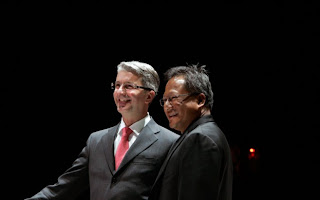|
Search This Blog
Tuesday, January 11, 2011
CES 2011: Audi Chairman Speaks of 3D HUD, Virtual Cabins
“Today a number of the foremost exciting innovations in client electronics, aren’t those in your living rooms and aren’t those in your offices. they're those within your automobile, (especially) if it’s an Audi,” said Rupert Stadler, Audi AG’s chairman, to a capability crowd at this year’s CES.
Aside from safety and inexperienced technology, Audi is seeking to enhance its customers’ infotainment expertise by keeping them informed and entertained, whereas at an equivalent time, alert to the road. Key to accomplishing this mission is software co-developer Elektrobit Automotive. The pair, who along are known as e.solutions, is keen on reducing the assembly time, improve the standard, and shorten generation gaps of in-car tech. It continues to meld and integrate the modular, hardware, and software aspects of latest systems, Stadler explained.
One forthcoming next-gen feature are going to be clear and vivid 3D heads-up displays that superimpose turn-by-turn arrows on actual streets seen ahead. Like today’s systems, they’ll additionally portray vehicle vitals like speed, temperature, etc. Navigation screens can still depict 3D maps in association with Google Maps.
“We found that if things are presented additional realistically, they need less driver attention and limit driver distraction,” Stadler announced.
During his keynote the chairman additionally highlighted the growing partnership Audi has established with software and hardware engineering firm NVIDIA. Jenson Huang, NVIDIA’s founder and CEO, was available to clarify his company’s latest Tegra a pair of system that currently powers the A8’s MMI.
According the Huang, Tegra a pair of is already powerful enough to form what he calls “virtual cockpits”, or those cockpits with totally digital displays and instruments.
“Doing a digital cockpit is unimaginable difficult,” Huang said. “The reason for that's that it's to possess crystal clear graphics, it's to render at sixty frames per second, and it's to appear realistic to the user. this can be the direction we’re going into.”
Such user interfaces are capable of nice visual feats.
“We will simulate any material,” Huang noted. “We will simulate metal. we are able to simulate aluminum or wood. however during this specific one (he points to a projected image) we’re simulating glass. And you'll be able to notice all the varied reflections, refractions, shadows and lighting.”
Stadler concluded with a prediction that looks all the additional plausible with every passing CES.
“Ultimately we tend to see a world where the automobile is totally connected to the globe of the net, to alternative cars, still on traffic and alternative knowledge streams. The automobile of the longer term is an element of the mobile world, in each sense of that word.”
